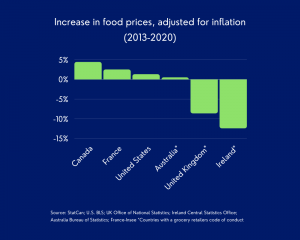November 8, 2021 –
DPAC and other national agricultural and food groups have called on governments to create a Grocery Code of Conduct. We believe that this move will help to address the imbalance of power that currently exists between Canada’s largest grocery retailers and their suppliers.
This imbalance makes our grocery supply chain inefficient, creates waste and increases administrative costs. Money that could be invested in processors’ own operations ends up going to large grocers in the form of fees and deductions or to the administrative processes required to confirm or dispute these large retailers’ claims. Further, it creates a climate of uncertainty which makes it difficult to accurately forecast business operations.
The experiences of other countries, like the United Kingdom, Ireland and Australia, have demonstrated that a Grocery Code can address these inefficiencies.
The experiences of these countries show that implementing Grocery Codes can bring about balance to supplier-retailer relationships, improve competition in the grocery retail environment, and support greater collaboration along the supply chain.
For example, the United Kingdom’s Groceries Code Adjudicator (GCA) has reported that, since 2015, there has been a steady decline in supplier complaints related to unfair business practices from large grocery retailers, such as: delay in payments, claims against suppliers for historic invoicing errors and omissions, fees related to forecasting and promotions, delivery issues, and consumer complaints.
The improved relationships and predictability created by a Grocery Code can create a level of certainty that allows processors to more confidently invest in their operations and product innovations. It also can reduce the number of additional costs that get passed along the supply chain.
This ties into the recent discussions on food inflation that we have been having in Canada. By addressing inefficiencies that increase costs, a Grocery Code can play a role in food prices.
For example, food prices in Ireland and the United Kingdom decreased significantly between 2013-2020. Pre-Brexit, food prices decreased by almost 9% in the United Kingdom and by more than 12% in Ireland following the adoption of mandatory codes. For comparison, food prices in Canada have increased by 4.4% in the same period. A difference of 13-15% is significant.
The steps these countries took to level the playing field ended up limiting administrative costs, waste, and unnecessary fees. When the system is more efficient, it reduces the costs that need to be passed on through to the consumer.
But, beyond food prices, a Grocery Code can play an important role in ensuring that Canada has the ability to grow and process food here at home now and in the future. Grocery Codes are an investment in domestic agricultural and processing sectors that are thriving and resilient.

Want to know more about how Grocery Codes work in other countries? View our case study on the United Kingdom’s Groceries Code Adjudicator.